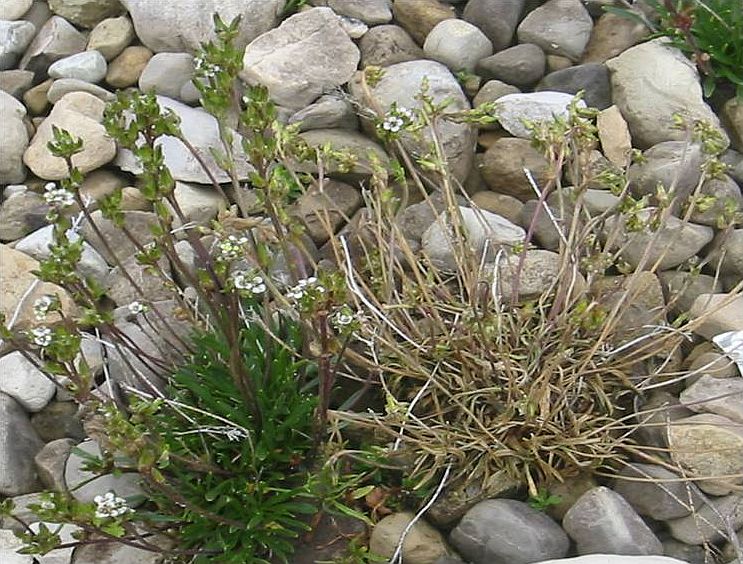There are three disease symptoms known to threaten the reproduction and survival of Long's Braya and
Fernald's Braya. Efforts to indentify and mitigate for these pathogens are ongoing.
Fusarium infection of Fernald's Braya
In the late 1990s, Delia (insect) species were detected in the roots of wilting Long's Braya that were growing on
human disturbed habitat. By 2004, research had concluded that this insect was the Seed Corn Maggot
(Delia platura) (Diptera:
Anthomyiidae), but that it was a secondary feeder on decaying Long's Braya roots, NOT
the initial cause. The real culprit was a fungus of the genus Fusarium.
A total of 599 Long's Braya individuals,
that died between 2003 and 2005, had symptoms of Fusarium infection (ie. wilted and decayed roots),
and all of these individuals were growing on human disturbed substrate.
No dead plants or wilting symptoms were seen in the
Fernald's Braya populations or in any undisturbed Long's Braya populations.

Fusarium infection. Fernald's Braya. Plant on left is healthy; plant on right is not.
[CLICK image to enlarge]
Long's Braya and Fernald's Braya flowering stalk infection
In 2003, approximately a dozen Long's Braya growing on human disturbed habitat had flowering stalks that
had lost their colour and had subsequently became mouldy. The symptoms always began on a single fruit, and colour
loss spread up and down the flowering stalk until the entire stalk was white. The flowering stalk then
became covered in a blue mould and wilted. This prevented seeds within the fruits from dispersing.
These symptoms have since spread to populations on undisturbed habitat, as well as to Fernald's Braya. On
average, 18% of tagged Long's Braya and 2% of Fernald's Braya are infected each year. Approximately 23% of
infected Long's Braya die the year following an infection compared with only 15% of flowering individuals
with no symptoms, in the same populations.

Braya flowering stalk infection. [CLICK image
to enlarge]
Unidentified pathogen of Fernald's Braya
This unidentified pathogen causes leaf and flowering stalk deformities and an increase in leaf pubescence
(ie. hairiness).
The pathogen was first collected from Fernald's Braya at Boat Harbour in 1925.
Since 1998, the same suite
of symptoms has been recorded on Fernald's Braya in the Watt's Point Ecological Reserve, in the Burnt Cape
Ecological Reserve, in the Anchor Point population, and in the Cape Norman population. Fernald's Braya
with these symptoms had a significantly higher mortality rate than those plants without symptoms; 35% of
infected plants died the year following infection compared to only 18% of plants showing no symptoms on the
same sites.

Unidentified pathogen of Fernald's Braya. [CLICK image to enlarge]
[PAGE UNDER CONSTRUCTION]
|





















